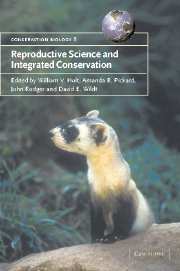Book contents
- Frontmatter
- Contents
- List of contributors
- Foreword
- Part I Introduction
- Part II Reproduction and population viability
- 2 Behaviour and reproduction
- 3 Nutrition and its interaction with reproductive processes
- 4 Environmental chemicals and the threat to male fertility in mammals: evidence and perspective
- 5 Assessing the consequences of inbreeding for population fitness: past challenges and future prospects
- 6 Impacts of inbreeding on components of reproductive success
- 7 The major histocompatibility complex (MHC) in declining populations: an example of adaptive variation
- 8 When is the birth rate the key factor associated with population dynamics?
- Part III Reproductive techniques for conservation management
- Part IV Integrated conservation management
- Part V Reproduction science in non-mammalian species
- Part VI Conclusions
- Index
- References
8 - When is the birth rate the key factor associated with population dynamics?
Published online by Cambridge University Press: 21 January 2010
- Frontmatter
- Contents
- List of contributors
- Foreword
- Part I Introduction
- Part II Reproduction and population viability
- 2 Behaviour and reproduction
- 3 Nutrition and its interaction with reproductive processes
- 4 Environmental chemicals and the threat to male fertility in mammals: evidence and perspective
- 5 Assessing the consequences of inbreeding for population fitness: past challenges and future prospects
- 6 Impacts of inbreeding on components of reproductive success
- 7 The major histocompatibility complex (MHC) in declining populations: an example of adaptive variation
- 8 When is the birth rate the key factor associated with population dynamics?
- Part III Reproductive techniques for conservation management
- Part IV Integrated conservation management
- Part V Reproduction science in non-mammalian species
- Part VI Conclusions
- Index
- References
Summary
INTRODUCTION AND OBJECTIVES
The role of reproductive technology in conservation biology, and the conditions under which the application of such technology is likely to succeed, will in part depend on the importance of fecundity rates on the dynamics of populations. For example, if a population is declining as a result of depressed fecundity rates, any improvement in the birth rate using reproductive technology may be of benefit. Conversely, if a population is declining because of depressed survival rates or increased emigration rates, then action that reverses these factors would be more relevant.
Birth, death, immigration and emigration generate patterns in the change of size of populations over time. Detecting and describing these patterns using field and statistical techniques are the mainstay of many population ecologists. They are also the first stage in understanding population dynamics well enough to make predictions or generalisations for the purposes of management, exploitation and conservation.
The size of a population in any year equals the size of the population in the previous year plus the number of individuals that have been recruited into the population by birth or immigration, minus the number of individuals that have been removed by death or emigration. The first step in trying to understand the processes associated with variation in the size of a population over time is to identify which vital rate (birth rate, survival rate or dispersal rate) is most strongly correlated with increases or decreases in population size.
- Type
- Chapter
- Information
- Reproductive Science and Integrated Conservation , pp. 114 - 128Publisher: Cambridge University PressPrint publication year: 2002



